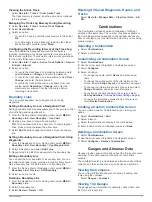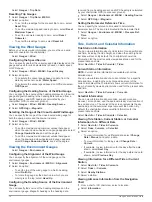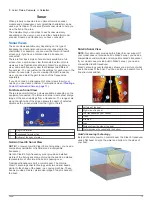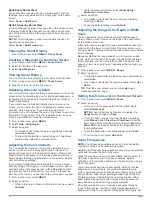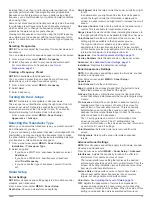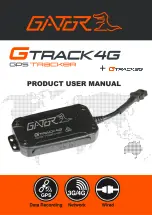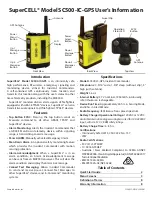
Adjusting Sea Clutter on the Radar Screen Automatically
You can set the chartplotter to automatically adjust the
appearance of clutter caused by choppy sea conditions.
NOTE:
Depending upon the radar in use, the sea clutter setting
configured for use in one radar mode may or may not be applied
to other radar modes or to the radar overlay.
NOTE:
Not all options and settings are available on all radar and
chartplotter models.
1
From a radar screen or the radar overlay, select
MENU
>
Noise Rejection
>
Sea Clutter
.
2
Select
Presets
or
Auto
.
3
Select a setting that reflects the present sea conditions.
When using a compatible radar model, the chartplotter adjusts
the sea clutter based on the sea conditions automatically.
Adjusting Rain Clutter on the Radar Screen
You can adjust the appearance of clutter caused by rain.
Reducing the radar range also can minimize rain clutter
(
Adjusting the Zoom Scale on the Radar Screen
The rain clutter setting affects the appearance of nearby rain
clutter and targets more than it affects the appearance of distant
rain clutter and targets. A higher rain clutter setting reduces the
appearance of clutter caused by nearby rain, but it can also
reduce or eliminate the appearance of nearby targets.
NOTE:
Depending upon the radar in use, the rain clutter settings
configured for use in one radar mode may or may not be applied
to other radar modes or to the Radar overlay.
1
From a Radar screen or the Radar overlay, select
MENU
>
Noise Rejection
>
Rain Clutter
.
2
Select
Up
or
Down
to decrease or increase the appearance
of nearby rain clutter until other targets are clearly visible on
the Radar screen.
Clutter caused by rain may still be visible.
Reducing Cross Talk Clutter on the Radar Screen
You can reduce the appearance of clutter caused by
interference from another nearby radar source, when the cross
talk reject setting is on.
NOTE:
Depending upon the radar in use, the cross talk reject
setting configured for use in one radar mode may or may not be
applied to other radar modes or to the Radar overlay.
From a Radar screen or the Radar overlay, select
MENU
>
Noise Rejection
>
Cross Talk Reject
.
Radar Display Settings
From any Radar screen or the Radar overlay, select
MENU
>
Radar Setup
.
Orientation
: Sets the perspective of the radar display. The
orientation setting applies to every radar mode. This setting
does not apply to the Radar overlay.
Appearance
: Sets the color scheme, look-ahead speed, and
navigation appearance.
Front of Boat
: Compensates for the physical location of the
radar scanner on a boat, if the radar scanner does not align
with the bow-stern axis.
Radar Appearance Settings
From a Radar screen, select
MENU
>
Radar Setup
>
Appearance
.
NOTE:
These settings do not apply to the Radar overlay.
Color Scheme
: Sets the color scheme.
Look-Ahead Speed
: Shifts your present location toward the
bottom of the screen automatically as your speed increases.
Enter your top speed for the best results.
Heading Line
: Shows an extension from the bow of the boat in
the direction of travel on the radar screen.
Rings
: Shows the range rings that help you to visualize
distances on the radar screen.
Nav. Lines
: Shows the navigation lines that indicate the course
you have set using Route To, Guide To, or Go To.
Waypoints
: Shows waypoints on the radar screen.
Front-of-Boat Offset
The front-of-boat offset compensates for the physical location of
the radar scanner on a boat, if the radar scanner does not align
with the bow-stern axis.
Measuring the Potential Front-of-Boat Offset
The front-of-boat offset compensates for the physical location of
the radar scanner on a boat, if the radar scanner does not align
with the bow-stern axis.
1
Using a magnetic compass, take an optical bearing of a
stationary target located within viewable range.
2
Measure the target bearing on the radar.
3
If the bearing deviation is more than +/- 1°, set the front-of-
boat offset.
Setting the Front-of-Boat Offset
Before you can set the front-of-boat offset, you must measure
the potential front-of-boat offset.
The front-of-boat offset setting configured for use in one radar
mode is applied to every other radar mode and to the Radar
overlay.
1
From a Radar screen or the Radar overlay, select
MENU
>
Radar Setup
>
Front of Boat
.
2
Select
Up
or
Down
to adjust the offset.
Device Configuration
Turning On the Chartplotter Automatically
You can set the chartplotter to turn on automatically when the
power is applied. Otherwise, you must turn on the chartplotter by
pressing .
Select
Settings
>
System
>
Auto Power
.
NOTE:
When Auto Power is On, and the chartplotter is
turned off using , and power is removed and reapplied
within less than two minutes, you may need to press to
restart the chartplotter.
System Settings
Select
Settings
>
System
.
Display
: Adjusts the backlight brightness and color scheme.
Beeper
: Turns on and off the tone that sounds for alarms and
selections.
GPS
: Provides information about the GPS satellite settings and
fix.
Auto Power
: Turns on the device automatically when power is
Turning On the Chartplotter Automatically
Language
: Sets the on-screen text language.
Speed Sources
: Sets the source of the speed data used to
calculate true wind speed or fuel economy. Water speed is
the speed reading from a water-speed sensor, and GPS
speed is calculated from your GPS position.
System Information
: Provides information about the device and
the software version.
Simulator
: Turns on the simulator and allows you to set the
speed and simulated location.
GPS Settings
Select
Settings
>
System
>
GPS
.
Device Configuration
21
Summary of Contents for AQUAMAP 80 Series
Page 1: ...AQUAMAP 80 100 Series Owner s Manual November 2016 Printed in Taiwan 190 01657 00_0C...
Page 6: ......
Page 35: ......





